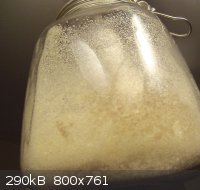nanobot-dnp
Harmless

Posts: 28
Registered: 9-11-2013
Member Is Offline
Mood: https://www.youtube.com/watch?v=cbvEmjHdeqQ
|
|
Is this mold in my 2,4-DNP?
I recently cleaned the product and recrystallized it. It has been in an air tight jar for about one month.
Noticed some browning on the inside of the glass and have included a picture of it.
Opened the jar to get a better look and notices a brown sticky glob rolling around near the surface coated in regular yellow crystals.
Is this mold or fungus? I never thought DNP could have such a thing grow in it. If so I might do some experimentation on it. Might be fun! 
Seriously it's not just moist its turned dark brown and sticky.

[Edited on 18-12-2013 by nanobot-dnp]
evil twists what is already there
|
|
|
bfesser
|
Thread Moved
18-12-2013 at 05:02 |
Random
International Hazard
    
Posts: 1018
Registered: 7-5-2010
Location: In ur closet
Member Is Offline
Mood: Energetic
|
|
There might be some contamination like citric acid, a citric acid solution or anything that touches it gets moldy. Maybe some ascorbic acid to prevent
oxidation or something like that?
|
|
|
Paddywhacker
Hazard to Others
  
Posts: 478
Registered: 28-2-2009
Member Is Offline
Mood: No Mood
|
|
2,4-dinitrophenol? I've never seen it that pale, however I doubt very much that anything could grow in it. Apart from the fact that it is a powerful
phenol it is also a potent metabolic toxin.
|
|
|
nanobot-dnp
Harmless

Posts: 28
Registered: 9-11-2013
Member Is Offline
Mood: https://www.youtube.com/watch?v=cbvEmjHdeqQ
|
|
Not sure whats in it. If anything can survive the purification method I use on it I would be surprised. Now that I think of it I have been purposely
contaminating it with magnesium sulfate. A little spice? ROFL
It can be colorless or very close... most people would say white when it is recrystallized in from HCL.
TO BE HONEST I have no idea what this is. It hasn't been analyzed. It does behave exactly like it is supposed to though. I'm 99% sure this is real
2,4-DNP.
One thing I cant quite convince myself of is the fact that I can hardly smell it. When I first got it the smell was quite strong but after treating it
the smell is hardly present.
evil twists what is already there
|
|
|
phlogiston
International Hazard
    
Posts: 1376
Registered: 26-4-2008
Location: Neon Thorium Erbium Lanthanum Neodymium Sulphur
Member Is Offline
Mood: pyrophoric
|
|
dinitrophenol is a very good proton decoupler, which means it dissipates proton gradients across biological phospholipid membranes.
All organisms rely on such gradients for energy 'generation', so if it is biological in nature it could be pretty interesting.
-----
"If a rocket goes up, who cares where it comes down, that's not my concern said Wernher von Braun" - Tom Lehrer |
|
|
Random
International Hazard
    
Posts: 1018
Registered: 7-5-2010
Location: In ur closet
Member Is Offline
Mood: Energetic
|
|
One way to check if it is biological would be taking the stuff and putting it on the petri dish. Some DNP contamination might prevent other bacteria
and fungus growing. Or maybe perhaps fungal cells are immune to DNP?
|
|
|
Paddywhacker
Hazard to Others
  
Posts: 478
Registered: 28-2-2009
Member Is Offline
Mood: No Mood
|
|
Fungi are eukaryotes, the same as us. They have mitochondria that use proton gradients across membranes to generate energy, as phlogiston said. All
such organisms will be unlikely to thrive.
So, the 2,4-dinitrophenol is so pale because you precipitated it out of hydrochloric acid? Likely it still has some HCl entrained. Maybe some iron,
a common contaminant in commercial HCl, is to blame, or maybe the entrained HCl is evaporating and your product is regaining its normal yellow colour.
|
|
|
Random
International Hazard
    
Posts: 1018
Registered: 7-5-2010
Location: In ur closet
Member Is Offline
Mood: Energetic
|
|
Still it might be some resistant form. I had fungus growing on concentrated waste solutions of heavy metal citrates like copper, iron, manganese..
Unlikely but still possible.
|
|
|
Mesa
Hazard to Others
  
Posts: 264
Registered: 2-7-2013
Member Is Offline
Mood: No Mood
|
|
When it's not being used for off-label weightloss, 2,4 Dinitrophenol is a pretty effective plant growth regulator. I've got a pretty decent
understanding of the pharmacokinetics of DNP in mammals, enough to know that the mechanism for its toxicity wouldn't impact plant/fungi the same way.
Other than that, I can only suggest converting to the Na phenolate salt or re-crystallizing(again.)
|
|
|
phlogiston
International Hazard
    
Posts: 1376
Registered: 26-4-2008
Location: Neon Thorium Erbium Lanthanum Neodymium Sulphur
Member Is Offline
Mood: pyrophoric
|
|
No, I have used DNP a lot for decoupling the mitochondrial proton gradient in various species of yeast (single celled fungi).
All known eukaryotes (including humans, fungi and plants) and prokaryotes (bacteria) rely on proton gradients across lipid membranes for ATP
production (an universally important intermediate store of metabolic energy in life on earth) and should therefore be sensitive to DNP.
However, if the concentration of DNP is low, it might be possible for some microorganism to metabolize the DNP to something less toxic and locally
create an environment where it can slowly grow. Also, the cell wall of some microorganisms may help keep the internal concentration low providing some
level of resistance.
[Edited on 16-1-2014 by phlogiston]
-----
"If a rocket goes up, who cares where it comes down, that's not my concern said Wernher von Braun" - Tom Lehrer |
|
|